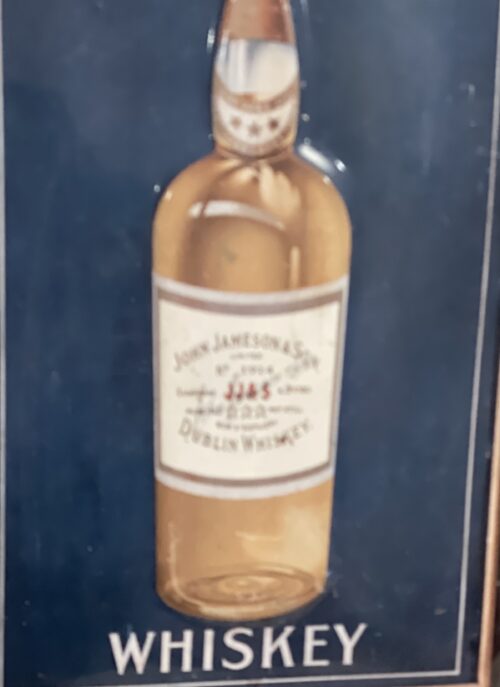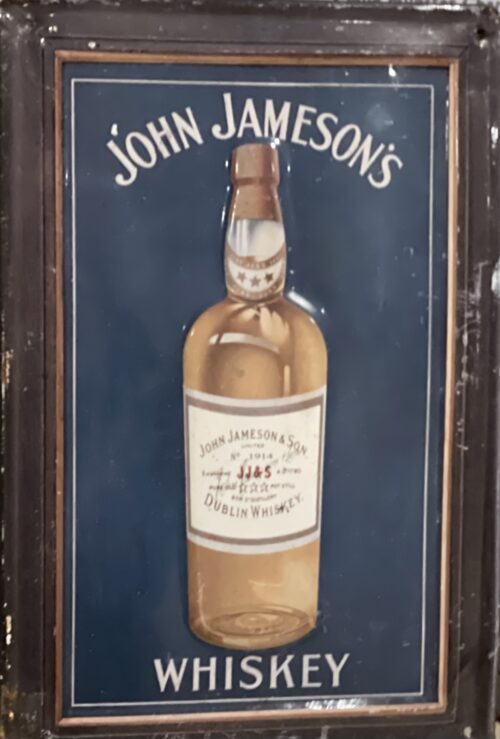28cm x 33cm
Christy Moore is one of Ireland's best known folk singer's, songwriter's and guitarist. He is one of the founding members of
Planxty and
Moving Hearts. His first album,
Paddy on the Road was recorded with
Dominic Behan in 1969. In 2007, he was named as Ireland's greatest living musician in
RTÉ's
People of the Year Awards.
Early life
Moore was born in
Newbridge, County Kildare, Ireland and attended
Dominican College Secondary School. He was originally a bank employee who wanted to express himself using traditional music. During a bank strike in 1966, which lasted twelve weeks, he went to England, as many striking officials did, but didn't return when the strike was settled. "I had a wild and wonderful time in England, with no bank manager looking over my shoulder," he said. Doing general labouring work, he frequented the folk clubs and the Irish music pubs where he met
Seamus Ennis,
Margaret Barry,
Luke Kelly, Martin Byrnes and many other traditional musicians.
When Irish singing trio
The Grehan Sisters, with whom Moore was previously acquainted, moved to the north of England from Dublin in 1967, they assisted Moore to get a higher profile by giving him contacts and support slots on their concerts.
Musical career
1973 brought his first major release,
Prosperous, which brought together the four musicians who shortly thereafter formed
Planxty:
Liam O'Flynn,
Andy Irvine and
Dónal Lunny. For a time they called themselves "CLAD", an acronym of their names, but soon decided on
Planxty.
After leaving Planxty in 1975, Moore continued on his solo career, reforming his old band on occasion (which he has been doing ever since). He also formed the band
Moving Hearts with Lunny and five other musicians in 1980. In 1987 he appeared on
Gay Byrne's
The Late Late Show performing with
The Dubliners for their 25th anniversary. In 2000, he published his autobiography,
One Voice.
Moore's earlier lifestyle resulted in a decline in health and several operations. Moore's battle with alcohol, and subsequent heart operations, have taken their toll. At the end of the 1990s, Moore reduced his workload for medical reasons.
Some of Moore's songs are heavily influenced by drink and the effects of drink, his song "Delirium Tremens" being a good example. Listening to Johnny Mulhern's song "Hard Cases" caused Moore to recall the Galway drinking scene with local musicians
Mickey Finn, Pete Galligan, Corky and Terry Smith.
On 17 April 2009, Moore released his first new studio album in four years, entitled
Listen, and promoted it through a series of live gigs.
In December 2011, Moore released the album
Folk Tale. His next album
Where I Come From was released in November 2013 and features a new protest song called "Arthur's Day". The album peaked at number three in the Irish album charts.
On the road was released in November 2017, while his most recent album
Magic Nightswas released in November 2019.
Political and social commentary
Moore is best known for his political and social commentary which reflects a left-wing,
Irish republican perspective, despite the fact that his mother was a
Fine Gael county councillor and parliamentary candidate in Kildare.
He supported the republican
H-Block protestors with the albums
H-Block in 1978, the launch of which was raided by the police, and
The Spirit of Freedom.
He has also recorded songs by the hunger striker
Bobby Sands, including "Back Home in Derry" which is based on
Gordon Lightfoot's song "
The Wreck of the Edmund Fitzgerald". He ceased supporting
the military activities of the
IRA in 1987 as a result of the
Enniskillen bombing.
Political songs he has performed throughout his career include
Mick Hanly's "On the Blanket" about the protests of republican prisoners,
"Viva la Quinta Brigada", about the Irishmen who fought in the
Spanish Civil War against
Franco, and "Minds Locked Shut" about
Bloody Sunday in Derry.
Moore has endorsed a long list of leftist support causes, ranging from El Salvador to
Mary Robinson in the 1990 presidential election.
At the
Glastonbury Festival in 2005, he sang about the Palestinian solidarity activist
Rachel Corrie. He supported the
anti-nuclear movement in Ireland playing in many concerts and at festivals in
Carnsore Point for the cause.
Banned songs
"They Never Came Home" is a song about the
Stardust fire of 1981 where 48 people died. The song was recorded on the
Ordinary Man album and was released on the B-side of a single in 1985. The song achieved notoriety when Moore was taken to court over claims in the song prejudical to an ongoing court case determining compensation. For instance, the song claimed, "hundreds of children are injured and maimed, and all just because the fire exits were chained". Mr Justice Murphy ordered the
Ordinary Man album to be withdrawn from the shops, and costs were awarded against Moore. "Another Song is Born" was recorded for the album's re-release. "They Never Came Home" later appeared on his box set and on the album
Where I come from.
Musical style
His solo style includes driving rhythms on guitar and
bodhrán as well as slower ballads.
Family
Moore's brother Barry, whose stage name is
Luka Bloom, is also a singer-songwriter.
His nephew, Conor Byrne, is also a traditional flautist and tin whistle player, with Christy appearing on his
Wind Dancer album.
Memorable events
Detention incident, 2004
In October 2004, Moore was stopped and detained by Special Branch officers at the Welsh port of Holyhead, taken into an office and questioned about the lyrics of his songs.
The following day, he released a statement saying: "My driver and I were stopped and held for two hours at Holyhead last Monday, under the
Prevention of Terrorism Act 2002. My driver and I were held separately in two interrogation rooms. I found the whole experience threatening. I was questioned about the contents of my briefcase." Despite initial reports to the contrary, the singer's van, which was full of musical equipment, was not searched. "I was questioned about lyrics of songs and I was asked a lot of personal questions about members of my family and my children and about my home. At no time was I given any explanation as to why I was being held and interrogated in this manner", he added. He said the fact that Irish people are still being treated this way on their way to Britain is very "saddening". "I had hoped to deal with this matter out of the public domain. But seeing as it has become a news item, I feel the need to offer my side of the story. I found the whole affair quite frightening."
Desert Island Discs
In June 2007, Moore was a guest on the BBC radio programme
Desert Island Discs.
He selected mainly Irish folk music that had inspired him and spoke of personal and political issues that had shaped his life, choosing a set of
Uilleann pipes as his luxury item and
The English and Scottish Popular Ballads as his choice book.
Penguin book of Irish poetry
In 2010 Christy Moore's song "Lisdoonvarna" which he wrote gained entry in
The Penguin Book of Irish Poetry.
Oxegen
On Sunday 10 July 2011 Moore joined
Coldplay on stage at the
2011 Oxegen Festival performing the song "
Ride On".











 47cm x 35cm
The old Smithwicks brewery is on the site of a Franciscan abbey, where monks had brewed ale since the 14th century, and ruins of the original abbey still remain on its grounds. The old brewery has since been renovated and now hosts "The Smithwick's Experience Kilkenny" visitor attraction and centre.At the time of its closure, it was Ireland's oldest operating brewery.
John Smithwick was an orphan who had settled in Kilkenny. Shortly after his arrival, Smithwick went into the brewing business with Richard Cole on a piece of land that Cole had leased from the Duke of Ormond in 1705. Five years later, John Smithwick became the owner of the land. The brewery stayed small, servicing a loyal local following while John Smithwick diversified.
Following John Smithwick's death, the brewery temporarily fell out of family hands. John Smithwick's great grandson, Edmond bought the brewery land back freehold and worked to reshape its future. Edmond concentrated on discovering new markets and successfully building export trade. Drinkers in England, Scotland and Wales developed a taste for Smithwick's brews and output increased fivefold.
As a result of substantial contributions made to St Mary's Cathedral, Edmond became great friends with Irish liberal Daniel O'Connell, who later became godfather to one of his sons. Edmond Smithwick became well known and respected by the people of Kilkenny who elected him town mayor four times.
In 1800, export sales began to fall and the brewing industry encountered difficulty. To combat this, the Smithwick family increased production in their maltings, began selling mineral water and delivered butter with the ale from the back of their drays.By 1900, output was at an all-time low and the then owner James Smithwick was advised by auditors to shut the doors of the brewery. Instead, James reduced the range of beers they produced and set out to find new markets. He secured military contracts and soon after saw output increase again. James' son, Walter, took control in 1930 and steered the brewery to success through the hardships of both World War II and increasingly challenging weather conditions.By January 1950, Smithwick's was exporting ale to Boston.Smithwick's was purchased from Walter Smithwick in 1965 by Guinness and is now, along with Guinness, part of
47cm x 35cm
The old Smithwicks brewery is on the site of a Franciscan abbey, where monks had brewed ale since the 14th century, and ruins of the original abbey still remain on its grounds. The old brewery has since been renovated and now hosts "The Smithwick's Experience Kilkenny" visitor attraction and centre.At the time of its closure, it was Ireland's oldest operating brewery.
John Smithwick was an orphan who had settled in Kilkenny. Shortly after his arrival, Smithwick went into the brewing business with Richard Cole on a piece of land that Cole had leased from the Duke of Ormond in 1705. Five years later, John Smithwick became the owner of the land. The brewery stayed small, servicing a loyal local following while John Smithwick diversified.
Following John Smithwick's death, the brewery temporarily fell out of family hands. John Smithwick's great grandson, Edmond bought the brewery land back freehold and worked to reshape its future. Edmond concentrated on discovering new markets and successfully building export trade. Drinkers in England, Scotland and Wales developed a taste for Smithwick's brews and output increased fivefold.
As a result of substantial contributions made to St Mary's Cathedral, Edmond became great friends with Irish liberal Daniel O'Connell, who later became godfather to one of his sons. Edmond Smithwick became well known and respected by the people of Kilkenny who elected him town mayor four times.
In 1800, export sales began to fall and the brewing industry encountered difficulty. To combat this, the Smithwick family increased production in their maltings, began selling mineral water and delivered butter with the ale from the back of their drays.By 1900, output was at an all-time low and the then owner James Smithwick was advised by auditors to shut the doors of the brewery. Instead, James reduced the range of beers they produced and set out to find new markets. He secured military contracts and soon after saw output increase again. James' son, Walter, took control in 1930 and steered the brewery to success through the hardships of both World War II and increasingly challenging weather conditions.By January 1950, Smithwick's was exporting ale to Boston.Smithwick's was purchased from Walter Smithwick in 1965 by Guinness and is now, along with Guinness, part of 























